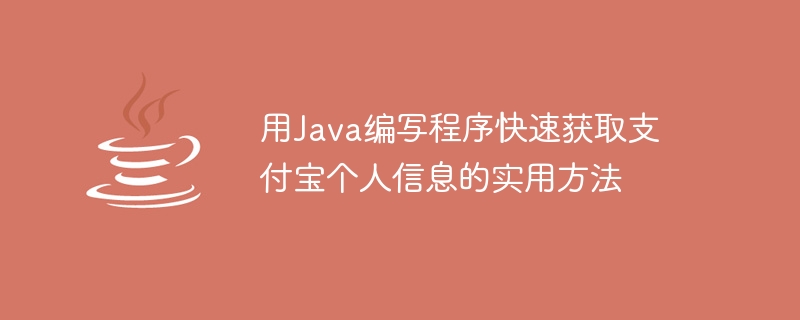Home >Java >javaTutorial >A practical method to quickly obtain Alipay personal information by writing a program in Java
A practical method to quickly obtain Alipay personal information by writing a program in Java
- PHPzOriginal
- 2023-09-06 13:16:521424browse

A practical method to quickly obtain Alipay personal information by writing a program in Java
Alipay is one of the most commonly used online payment platforms in China and is used by many people in their daily lives. It makes payments and transfers. If we want to obtain our personal information from Alipay, such as account balance, transaction records, etc., we can use Java to write a program to achieve this function. This article will introduce a practical method to quickly obtain Alipay personal information and provide corresponding code examples.
To realize this function, we can use the open interface provided by Alipay to obtain personal information through HTTP requests and JSON parsing. Below is a sample code that demonstrates how to implement this functionality using Java.
import java.io.BufferedReader;
import java.io.InputStreamReader;
import java.net.HttpURLConnection;
import java.net.URL;
public class AlipayInfo {
public static void main(String[] args) {
// 设置支付宝开放平台的API地址和应用ID
String apiUrl = "https://openapi.alipay.com/gateway.do";
String appId = "your_app_id";
// 构造请求URL
String requestUrl = apiUrl + "?app_id=" + appId + "&method=alipay.user.info.share";
try {
// 发送HTTP GET请求并获取响应结果
URL url = new URL(requestUrl);
HttpURLConnection connection = (HttpURLConnection) url.openConnection();
connection.setRequestMethod("GET");
BufferedReader reader = new BufferedReader(new InputStreamReader(connection.getInputStream()));
String line;
StringBuilder response = new StringBuilder();
while ((line = reader.readLine()) != null) {
response.append(line);
}
reader.close();
// 解析JSON响应结果,并输出个人信息
String jsonString = response.toString();
// TODO: 使用JSON解析库解析jsonString获取个人信息
System.out.println(jsonString);
} catch (Exception e) {
e.printStackTrace();
}
}
}In the above code, we first define the API address and application ID of the Alipay open platform. Then, we construct a request URL, which contains the application ID and method name. Next, we send an HTTP GET request, obtain the response result, and parse the response result into JSON format. Finally, we can use the JSON parsing library to parse the JSON string and obtain personal information.
It should be noted that in order to run the above code, we need to register and create an application on the Alipay open platform and obtain the application ID. At the same time, we also need to introduce a JSON parsing library, such as Google's Gson library or Alibaba's FastJSON library, to parse JSON strings.
Using this method, we can quickly obtain Alipay personal information and further process and display it as needed. Of course, in addition to obtaining personal information, the Alipay open platform also provides many other interfaces, such as payment, refund, etc., which can be developed and called as needed.
To summarize, this article introduces a method to quickly obtain Alipay personal information by writing a program in Java. We accomplish this by constructing the request URL, sending the HTTP request, and parsing the JSON response. We hope that readers can further expand and optimize this function based on the sample code and ideas provided in this article to meet their actual needs.
The above is the detailed content of A practical method to quickly obtain Alipay personal information by writing a program in Java. For more information, please follow other related articles on the PHP Chinese website!

